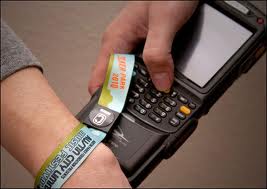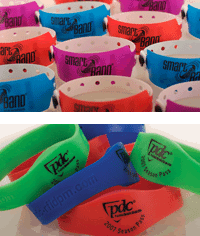
RFID Wristband
RFID enabled wristbands are used for various purposes across a number of industries. Schools, hospitals, amusement parks, militaries, cruise ships and a number of other enterprises are moving forward with projects to put RFID tags into wristbands. RFID enabled wristbands are ideal for various applications where it is vital to provide location or privileged services to patrons, patients, workers, temporary visitors or other personnel groups. Some of the applications that come to mind are in healthcare, where these wristbands can provide patient safety and security; in the entertainment industry where wristbands can be used for convenience and customer safety; the U.S. Department of Defense can use RFID wristbands to track soldiers, and combat casualties, and higher education facilities could used RFID wristbands to monitor attendance and increase student safety. While the above mentioned applications are important, the list does not end there, RFID wristbands can be used across most industries for various applications.
What is an RFID Enabled Wristbands?
In simple terms, RFID wristband systems contain two parts: a tag and a reader. An RFID tag embedded in the wristband contains an antenna; the majority of these tags are passive. Passive RFID tags are small data transponders that are powered by the radiation received from a querying RFID reader – these tags “wake – up” when irradiated by the reader.Active RFID wristbands contain batteries and can send signals to readers. Readers can be mounted on walls, doorways, ceiling or be hand held.A lost child wearing a barcode wristband in RFID wristband in an amusement park can be located by the reader infrastructure which then transmits that location information to his/her parents.
RFID Wristbands in Healthcare:
There are many applications for RFID technology in healthcare. RFID wristbands specifically can be used in patient safety applications.These applications can provide patient tracking and identification services through the use of RFID wristbands. Additionally the use of RFID wristbands in healthcare can improve resource utilization and expedite patient admission process within all hospital departments. Due to the lack of real-time data, majority of the hospitals find it hard to keep track of their patients’ whereabouts while the hospital staff is on the move, thus leading to delays in patient admission from the emergency department.By assigning RFID wristbands to patients at the point of admission, recording patient information on these wristbands and strategically placing RFID readers throughout the hospital, patients can be located and identified while moving freely around the hospital, thus decreasing delays throughout the hospital.
In addition, RFID wristbands can be used to record patient information to correctly identify patients.Incorrect identification of patients can lead to incorrect drug administration, execution of undesired procedures, misfiling of results and medical documentation and can cause general delays.RFID enabled wristbands can, not only store patient information, but can have read and write capabilities as well.Usually, nurses and hospital personnel take notes by hand and then enter them into databases, leaving room for human error and causing general delays in hospital proceedings.With RFID enabled wristbands patient information, can be retrieved from the database via a wireless network by getting RFID enabled handheld devices in the vicinity of the wristbands. Hospital personal can obtain information on their patient instantly through patient’s wristband. With the use of RFID enabled wristbands doctors and nurses can monitor patients’ in real time, decrease mistakes and allow for a faster patient admission and treatment.
Some hospitals are already employing RFID enabled wristbands to help them track and identify patients. In 2003, The Albert Einstein Healthcare Network in Philadelphia, PA deployed a passive RFID identification tracking system. Since the deployment the hospital increased emergency department traffic flow by 24% and decreased the number of patients leaving before receiving care by 3%.
RFID Enabled Wristbands in the Entertainment Industry
RFID wristbands can have various applications in the entertainment industry. Amusement parks, cruises, concerts and festivals could all benefit from RFID wristband deployment. RFID wristbands in amusement parks can provide customers with convenience and security. According to some studies, over 27% of all families that visit an amusement park loose one of their children while there. With the use of RFID wristbands parks can prevent children from being lost.RFID wristbands assigned to park goers at the point of ticket purchase, can store basic information such as name, telephone number and address of the person wearing the wristband. Parents with lost children could go to park administration and retrieve their child’s location.Paramount’s Great American in Santa Clara, CA is a perfect example of an amusement park using RFID enabled wristbands to track park goers. Great American attendees get RFID wristbands with his/her name. One of many antennas scattered throughout the park –whichever is closest to the person at any given moment –reads the wristband and sends the information to the park’s administration.Parents who lose their children can go to any service kiosk, wave their own wristband, and bring up maps showing their kids’ locations.
Cruises, concerts and festivals could all benefit from similar RFID wristband applications. By utilizing RFID enabled wristbands, these ventures can not only track their customers but also provide them with convenience and security.
Royal Caribbean Oasis did just that, when it set sail in December 2009. The world’s largest cruise ship provided its customers with RFID wristbands that not only offered families and groups a way to track their members, but to also allowed users to make reservations at restaurant’s and spas. The application used Wi-Fi based RFID tags in wristbands and Apple iPhones. The location information was transmitted to the iPhone user to send alerts, to those wearing wristbands. This allowed for users to move freely about the cruise ship without worrying about their family members being lost. 2Live sector can also benefit from RFID wristband deployment. By storing bank account information on RFID enabled wristbands, attendees will not need to bring their debit cards, cash, and credit cards to the venue, therefore eliminating theft that occurs at concerts, sporting events and other similar events. Similarly, medical information can be stored on RFID wristbands, therefore upgrading safety for individuals in case of an emergency. Additionally, RFID enabled wristbands allow administration personal to monitor the crowds. By scanning wristbands by readers that contain all of the information of all the wristband holders attending, and sending this data wirelessly to a server, crowds can be monitored and controlled in real time. In 2004, South by Southwest (SXSW), a music festival held annually in Austin, Texas, used RFID wristbands to prevent counterfeiting of wristbands, eliminate over – crowding and to increase public safety at their events.
RFID Wristband Application in Defense
RFID enabled wristband applications vary when it comes to defense. These wristbands can be used to track wounded in warfare, track soldiers on battlefields, help families track relatives and identify victims during natural disasters. In 2007, U.S. Navy used RFID enabled wristbands to track and identify the wounded naval officers arriving at the field hospitals in Iraq. By employing RFID wristbands and satellite communication, medical personnel could better plan for arriving casualties. Additionally, the U.S. military has been considering using RFID to track soldiers on the battlefield to warn and monitor those going in and out of chemical or biological hot zones.
Some companies have been employing RFID wristbands to help families prevent their loved ones, who are at risk, from wandering away from the house. If an individual wearing the wristband approaches a door, an alarm sounds. This application is perfect for individuals suffering from Alzheimer’s or similar conditions.
Additionally, the state of Texas used RFID wristbands to track victims of hurricane Ike and Gustav. In 2008, the state’s division of Emergency Management employed RFID wristbands to evacuate 34,800 residents.
Moving Forward
RFID wristbands can be used across many industries, and in various applications. However, the same holds true regardless of the industry or the application: RFID wristbands are becoming the standard in people identification and tracking.RFID enabled wristbands are used in healthcare, defense, entertainment industries and even some schools are starting to employ RFID to track student attendance. While the cost of RFID wristband systems may seem daunting, the system’s ability track patients in hospitals, cut down cost of counterfeit tickets at festivals, increase security and track wounded is a major plus.


